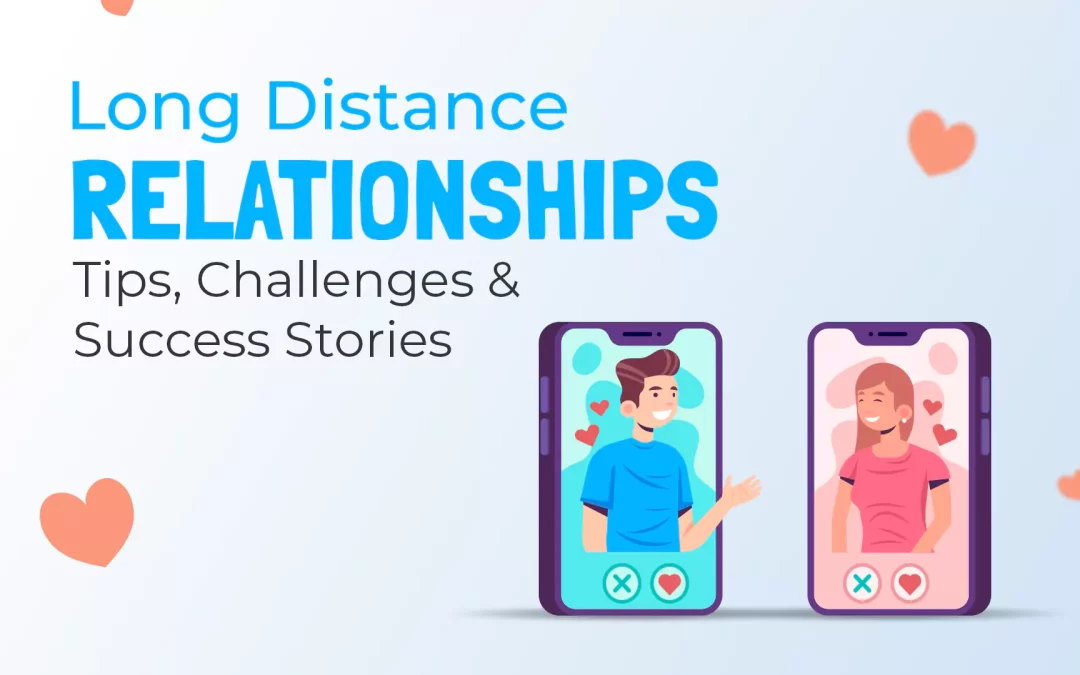Long-distance relationships have become more common because of advancements in technology and changes in work and travel opportunities. These partnerships can prosper and grow despite the difficulties they provide and the potential for huge rewards. This article explores the topic of long-distance relationships, covering their journey, difficulties, helpful advice, and motivational success stories.
Overcoming Challenges in Long-Distance Relationships and Tips
Although distant relationships have their share of difficulties. They can be effectively managed with effort and open communication. Here are some common challenges and tips for preserving a strong long-distance relationship:
1. Communication barriers
Communication barriers in distant relationships can arise due to various factors. Some common communication challenges include:
- Time Zone Differences: Living in different time zones can make it difficult to find suitable times for meaningful conversations. Scheduling regular calls or video chats might be challenging due to conflicting schedules.
- Limited Face-to-Face Interaction: Being physically apart reduces non-verbal cues and facial expressions, which can sometimes lead to misinterpretation or misunderstanding of messages.
- Technological Issues: Unreliable internet connections or technological glitches during calls can disrupt communication and cause frustration.
- Busy Schedules: Demands of work, study, or other responsibilities can reduce the time available for communication, leading to less frequent interactions.
- Communication Styles: Different communication styles and preferences may lead to misunderstandings or ineffective conversations.
- Emotional Barriers: Some individuals find it challenging to express their emotions through digital means, which can hinder open and honest communication.
So, living in different time zones can make it difficult to find suitable times for meaningful conversations. Scheduling regular calls or video chats might be challenging due to conflicting schedules.
How to Deal with
To overcome communication barriers in a long-distance relationship and maintain a strong connection, consider implementing the following tips:
- Establish Communication Routine: Set a regular schedule for calls, video chats, or messaging. Having predictable communication times helps both partners stay connected and manage expectations.
- Choose Suitable Communication Channels: Utilize various communication platforms that work best for both of you, such as video calls, voice messages, texting, or social media. Adapt to each other’s preferences.
- Be Patient and Understanding: Recognize that communication might be disrupted due to time zone differences or busy schedules. Be patient with each other’s availability and understand that delays can happen.
- Practice Active Listening: Listen attentively to each other’s thoughts, feelings, and concerns. Avoid interrupting and show genuine interest in what the other person is saying.
- Use Visual Aids: Share photos or videos of your day-to-day activities to create a visual connection and keep each other updated on your lives.
- Avoid Misinterpretation: Clarify messages that might be ambiguous or unclear to avoid misunderstandings. Ask for clarification if needed and be clear in expressing your thoughts.
- Celebrate Milestones: Acknowledge important events and milestones in each other’s lives, even from a distance. Celebrate achievements and special occasions to strengthen your emotional bond.
- Practice Virtual Activities: Organize virtual date nights where you can share a meal or participate in online activities together.
- Be Honest and Open: Share your feelings and emotions honestly, even if it’s challenging. Open communication builds trust and emotional intimacy.
- Limit Distractions: During your communication sessions, minimize distractions to ensure your focus is solely on each other.
- Resolve Conflicts Constructively: If disagreements arise, address them respectfully and constructively. Avoid letting conflicts linger and work together to find solutions.
- Send Surprise Messages or Gifts: Surprise your partner with unexpected messages or small gifts to show your affection and thoughtfulness.
Remember that effective communication is essential in any relationship, especially in a long-distance one. By being proactive, patient, and understanding, you can navigate communication barriers and foster a healthy and fulfilling long-distance relationship.
2. Feelings of loneliness
One of the main challenges in long-distance relationships is the distance between partners. This can make it hard to stay emotionally connected and close, which are important for a good relationship. Also, the lack of physical contact can be frustrating and challenging for both partners, especially if they are used to being physically close to each other. Moreover, physical distance may lead to feelings of isolation and longing for each other’s company. Feelings of loneliness are a common and significant challenge in long-distance relationships. Physical separation can lead to a sense of isolation and longing for the presence of the partner. Several factors contribute to this loneliness:
- Physical Absence: The inability to be physically together can lead to a profound emotional void, as the couple misses out on shared experiences and everyday interactions.
- Lack of Emotional Support: Being apart during difficult times or stressful situations can leave individuals feeling unsupported, as they are unable to provide immediate comfort to their partner.
- Limited Social Life: Long-distance partners might feel socially isolated as they miss out on events and gatherings with each other’s friends and family.
- Dependence on Technology: While technology enables communication, it can also remind partners of the distance, amplifying feelings of loneliness.
How to Deal with
To cope with feelings of loneliness, it is crucial for both partners to:
- Prioritize Communication: Regular and meaningful communication can help combat feelings of isolation. Stay connected through calls, video chats, and texting.
- Share Emotions Openly: Talk about feelings of loneliness with each other and express emotional needs and vulnerabilities without hesitation.
- Engage in Hobbies and Interests: Pursue individual hobbies and activities to create a sense of fulfillment and maintain a healthy sense of self.
- Build a Support System: Lean on friends and family for emotional support and companionship when feeling lonely.
- Focus on Quality Time: Make the most of the time spent together, even if it’s through virtual means, and create memorable experiences.
- Practice Self-Care: Prioritize self-care and personal growth to build resilience and emotional well-being.
- Plan Visits and Reunions: Whenever possible, arrange visits to spend time together in person. Having reunions helps strengthen the emotional connection and maintain the excitement in the relationship.
By acknowledging and addressing feelings of loneliness and actively working together to overcome them, couples in far-off relationships can find ways to stay connected and nurture their emotional bond despite the physical distance.
2. Trust issues
Trust issues can be a significant challenge in long-distance relationships. The physical separation and lack of daily interactions can sometimes give rise to doubts and insecurities. Some factors contributing to trust issues in distant relationships include:
- Limited Face-to-Face Contact: The inability to be physically present with each other might lead to uncertainties about the partner’s actions and intentions.
- Communication Gaps: Misunderstandings or misinterpretations in communication, especially through digital means, can erode trust.
- Feeling Disconnected: Long periods of separation can make partners feel distant, leading to doubts about the strength of the relationship.
- Jealousy: The fear of the partner developing feelings for someone else due to the physical distance can lead to jealousy and suspicion.
- Previous Negative Experiences: Past experiences, such as infidelity or betrayal, can influence a person’s ability to trust in a long-distance relationship.
How to deal with it
To address trust issues in long-distance relationships, it’s crucial for both partners to:
- Communicate Openly: Have honest and transparent conversations about fears, insecurities, and concerns related to trust.
- Be Reliable: Demonstrate consistency and reliability in communication and actions to build trust.
- Set Boundaries: Establish clear boundaries and expectations to prevent misunderstandings and ensure both partners feel respected.
- Avoid Keeping Secrets: Be open about personal experiences and interactions with others to foster trust and reduce suspicion.
- Address Past Issues: If trust issues stem from past experiences, work together to heal and rebuild trust, seeking professional support if necessary.
- Show Appreciation: Express gratitude and appreciation for each other’s efforts and commitment to reinforce trust.
- Stay Committed: Demonstrate commitment to the relationship through consistent effort and reassurance.
Building trust in a distant relationship requires time, effort, and patience. Both partners must be willing to work together, communicate openly, and actively address any trust-related concerns to strengthen the foundation of their relationship.
Success Stories
Long-distance marriages can be challenging, but many couples have overcome the distance and built successful and enduring partnerships. Here are a few inspiring success stories:
Adam and Sarah: Adam and Sarah were college fellows who got married after graduation. However, due to job opportunities in different cities, they had to live apart for a few years. They maintained their emotional bond through regular phone calls and video chats. They made it a priority to spend holidays and special occasions together. Their commitment to each other and their willingness to make sacrifices paid off when they eventually reunited and started their life together in the same city.
Hasnain and Fatima: David and Emily met through a website for an online matrimonial platform, and they instantly clicked. They were both dedicated to their respective careers and lived in different states. Despite the distance, they supported each other’s goals and aspirations. They made sure to have regular visits and planned weekend getaways to strengthen their connection. After a year of long-distance marriage, they get together and celebrated their union with friends and family.
The Takeaway
Overall, long-distance relationships demand a concerted effort, unwavering patience, and profound understanding from both partners. Embracing open communication, fostering unwavering trust, and demonstrating unwavering commitment empowers couples to triumph over challenges and savor the extraordinary allure of their love story. However, it is crucial to remember that each long-distance relationship is one-of-a-kind, and the strategies that bring success for one couple may differ for another. Flexibility and adaptability are key as partners navigate their individual journeys in crafting a resilient and fulfilling connection despite the physical distance.


Good write up and cute stories.
Your blog posts are engaging and captivating. Looking forward to staying connected for your upcoming content.